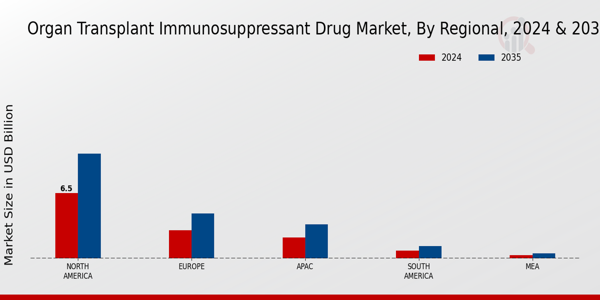Market Growth Projections
The Global Organ Transplant Immunosuppressant Drug Market Industry is projected to experience substantial growth in the coming years. With a market value of 12.5 USD Billion in 2024, it is anticipated to reach 20.2 USD Billion by 2035, reflecting a robust CAGR of 4.43% from 2025 to 2035. This growth is driven by various factors, including advancements in medical technology, increased awareness of organ donation, and the rising prevalence of chronic diseases necessitating transplants. The market's trajectory indicates a promising future for immunosuppressant therapies, as they play a critical role in ensuring the success of organ transplantation.
Growing Geriatric Population
The aging population globally is a crucial driver of the Global Organ Transplant Immunosuppressant Drug Market Industry. As individuals age, the likelihood of organ failure increases, leading to a higher demand for transplants. According to the World Health Organization, the number of people aged 60 and older is expected to double by 2050, reaching 2.1 billion. This demographic shift necessitates effective immunosuppressive therapies to ensure successful transplant outcomes. Consequently, the market is poised for growth, as healthcare systems adapt to the needs of an older population requiring organ transplants and associated immunosuppressants.
Government Initiatives and Funding
Government initiatives aimed at increasing organ donation rates and funding for transplant programs significantly influence the Global Organ Transplant Immunosuppressant Drug Market Industry. Various countries have implemented policies to promote organ donation, such as public awareness campaigns and financial incentives for donors. For instance, the U.S. government has allocated substantial resources to improve transplant infrastructure and support research in immunosuppressant therapies. These efforts not only enhance the availability of organs but also stimulate the market for immunosuppressants, as more successful transplants lead to a higher demand for these critical medications.
Rising Prevalence of Organ Transplants
The increasing incidence of organ transplants globally drives the Global Organ Transplant Immunosuppressant Drug Market Industry. As more individuals suffer from chronic diseases such as diabetes and kidney failure, the demand for organ transplants rises. For instance, the number of kidney transplants performed in the United States has seen a steady increase, with over 23,000 procedures reported in 2022 alone. This trend is expected to continue, contributing to the projected market value of 12.5 USD Billion in 2024. The growing need for effective immunosuppressants to prevent organ rejection underscores the importance of this market.
Advancements in Immunosuppressive Therapies
Innovations in immunosuppressive therapies are pivotal in shaping the Global Organ Transplant Immunosuppressant Drug Market Industry. Newer drugs with improved efficacy and reduced side effects are being developed, enhancing patient outcomes. For example, the introduction of biologic agents has transformed treatment protocols, allowing for more personalized approaches. These advancements not only improve patient adherence but also reduce the risk of transplant rejection. As the market evolves, it is anticipated to grow at a CAGR of 4.43% from 2025 to 2035, reaching an estimated 20.2 USD Billion by 2035, reflecting the ongoing commitment to enhancing transplant success rates.
Emerging Markets and Increased Healthcare Access
Emerging markets are becoming increasingly significant in the Global Organ Transplant Immunosuppressant Drug Market Industry. Countries in Asia and Latin America are witnessing improvements in healthcare infrastructure and access to transplant services. For example, India and Brazil are investing in their healthcare systems, leading to a rise in organ transplant procedures. This trend is expected to contribute to the overall market growth, as these regions require effective immunosuppressants to support their expanding transplant programs. The increasing accessibility of healthcare services in these markets presents a substantial opportunity for the immunosuppressant drug industry.

























Leave a Comment